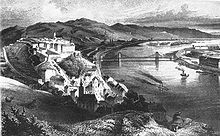Tabán

The Tabán usually refers to an area within the
Elisabeth Bridge and to the east of Naphegy
. Several other Hungarian cities and towns also have districts called Tabán.
History

The Tabán has been inhabited since Neolithic times due to its location in a protected valley, the thermal waters at the bottom of the
Gellért Hill, and the ford over the Danube. In the Iron Age, it was inhabited by a tribe of Celts, who were replaced by the Romans
in the 1st century BC.
In the
Ottoman occupation of Hungary, the Turks developed the thermal medicinal baths in the area and brought in settlers from the Balkans. The population increased after the 1686 liberation of Buda from as refugees arrived from Greece, Bosnia and Serbia. The Franciscans from Bosnia established the Tabán parish Church of St. Catherine of Alexandria in the 17th century; the church was rebuilt in Baroque style between 1728 and 1777 and reconstructed several times. The Serbian Orthodox inhabitants established their own parish. The Church of St. Demetrius was built in 1742-51 in Baroque style; it was the largest church building in the Metropolitanate of Karlovci. In the 18th century, the town was inhabited by Serbs, Greeks, Vlachs, Germans, Croats, Slovaks and Gypsies
.
By the 19th century, the Tabán became known as a
Mediterranean
atmosphere. Kereszt Street was at the center of this district.
In the 1930s, the Tabán was demolished as part of a project of urban renewal in Budapest. Today, it is a popular park.
Topography
After the 1930
Gellérthegy and Tabán Czakó Street in Naphegy
.
Taban's historic and cultural attractions include a Memorial of the
1956 Hungarian Revolution
near Naphegy Street and Kereszt Street and the Semmelweiss Orvostörténeti Múzeum near Apród Street.
Tabán in literature
The poet Dezső Kosztolányi wrote:
"Köröttem - esős akvarell - Tabán.
Nyugodt lennék itt s boldog is talán..."
"I crossed Tabán - a rainy watercolour.
I would be at peace here and maybe happy too..."
Sights
Major sights include
Gallery
-
The old Tabán school was here, today sports field Naphegy near Czakó Street, Tabán's historic places 1945 - 2003
-
The last Tabán house; Czakó Street–Aladár Street in 2003, Tabán's historic places 1945 - 2003
-
Tabán Springtime 2003, Tabán park today 2003 - 2004
-
May 1. 2003, Tabán park today 2003 - 2004
-
Memorial 1956 -1956 Hungarian Revolution, Tabán park today 2003 - 2004
-
Playground, Naphegy utca - Hadnagy utca, Tabán park today 2003 - 2004
Sources
- Budapest Lexikon (Second edition, revised and expanded). 2 volumes. Akadémiai Kiadó, Budapest, 1993.
- Narodni Kalendar 1990, Aqua Kiadó és Nyomda, Budapest, 1990.
- Antal Szerb: Budapesti kalauz Marslakók számára (A Guide to Budapest for Martians)
See also
Wikimedia Commons has media related to Tabán.
The following are near Tabán:
- Gellert Hill
- Naphegy
- Krisztinaváros
- Buda Castle






